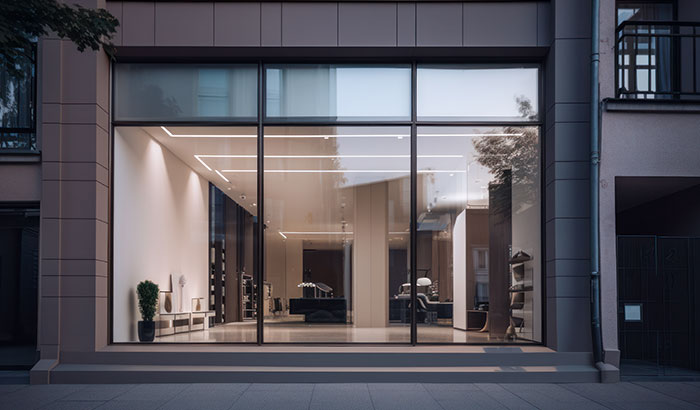
Your storefront is your business’s first impression, and it’s crucial to make a great one. Your storefront glass window plays a huge role in creating an attractive and inviting appearance for your shop. A well-designed storefront can attract more customers, build your brand, and improve your overall business performance.
Therefore, it’s important to be aware of the different types of glass available and the factors you need to consider when choosing the right one for your storefront. That’s where this blog will come in handy!
Types of Glass
Choosing the right type of glass for your storefront is a key aspect of creating an attractive and safe commercial space. The storefront glass serves a dual purpose of contributing to the appearance of the store while also providing necessary safety features such as durability, strength, and resistance to impact.
The right type of glass will provide an appropriate balance between functionality and aesthetics to ensure that your storefront is not only visually appealing but also safe for your customers and employees.
Here are the most common types of glass for storefronts:
- Tempered Glass – Tempered glass is a safety glass that is heated and cooled rapidly to make it stronger and more durable than regular glass. It is designed to shatter into small, blunt pieces when broken, reducing the risk of injury.
- Laminated Glass – Laminated glass is a type of safety glass that is made by sandwiching a layer of polyvinyl butyral (PVB) between two sheets of glass. If the glass breaks, the PVB layer holds the glass together, preventing it from shattering and reducing the risk of injury.
- Insulated Glass – Insulated glass, also known as double-glazed glass, is made by sealing two or more glass panes together with an air or gas-filled space between them. This design improves thermal insulation, reducing heat loss and noise transmission.
- Wired Glass – Wired glass is a type of safety glass that has a wire mesh embedded within it to prevent it from shattering. It is commonly used in areas that require fire resistance, such as fire doors and windows.
- Tinted Glass – Tinted glass is a type of glass that has a tinted color or reflective coating applied to it. This design can reduce glare, improve privacy, and improve the energy efficiency of the building.
- Low-E Glass – Low-E (low-emissivity) glass is a type of glass that has a thin, transparent coating applied to it that reduces the amount of heat that passes through the glass while still allowing visible light to enter. This design improves energy efficiency and reduces the amount of ultraviolet (UV) light that enters the building, protecting interior furnishings from fading.
When selecting a type of glass for your storefront, it’s important to consider factors such as location and climate, safety and security, energy efficiency, aesthetics and branding, and cost. Understanding the properties and benefits of each type of glass can help you make an informed decision that suits your business’s needs.
Considerations for Glass Selection
When selecting the right type of glass for your storefront, there are several important factors to consider. The right type of glass will provide an appropriate balance between functionality and aesthetics to ensure that your storefront is not only visually appealing but also safe for your customers and employees.
Here are some key considerations to keep in mind:
- Location and Climate – The location and climate of your store can play a significant role in determining the type of glass that is best suited for your storefront. If you are located in an area with severe weather conditions such as hurricanes or high winds, you may need to choose a more durable and impact-resistant glass.
Additionally, if your store is exposed to high levels of sunlight, you may want to consider glass with a tint or a reflective coating to reduce heat gain.
- Safety and Security – Safety and security are essential factors to consider when selecting storefront glass. Safety glass, such as tempered or laminated glass, can reduce the risk of injury in the event of breakage. You may also want to consider security glass, which is designed to resist forced entry and protect against vandalism.
- Energy Efficiency – Energy-efficient glass can help reduce heating and cooling costs by minimizing the amount of heat that is transferred in or out of the building. Options such as low-E or insulated glass can help improve energy efficiency and reduce utility costs.
- Aesthetics and Branding – The appearance of your storefront is crucial in creating an inviting atmosphere for your customers. The right type of glass can enhance the overall aesthetics of your storefront, contributing to your brand image and marketing efforts.
You may want to consider tinted or decorative glass options to create a unique and visually appealing storefront.
- Cost – Cost is an important consideration when selecting storefront glass. While high-end options such as security or energy-efficient glass may have a higher upfront cost, they can provide long-term cost savings through reduced energy bills, improved safety, and increased durability.
By carefully considering these factors when selecting storefront glass, you can ensure that you choose the right type of glass that provides a perfect balance of functionality, safety, aesthetics, and cost-effectiveness for your business.

Storefront Glass Replacement
Over time, a storefront glass window can become damaged, cracked, or outdated, compromising the safety, appearance, and energy efficiency of your business. In this section, we’ll explore some signs that indicate it’s time to replace your storefront glass window, steps to take when replacing it, and tips for hiring a professional.
Signs that replacement is necessary
There are several signs that indicate that it’s time to replace your storefront glass, including:
- Cracks, chips, or fractures in the glass
- Foggy or hazy appearance due to a broken seal
- Leaks or drafts around the glass edges
- Difficulty in opening or closing the windows
- Outdated or unattractive appearance
If you notice any of these signs, it’s essential to replace your storefront glass as soon as possible.
Steps to take when replacing storefront glass
When replacing storefront glass, there are several steps to take to ensure a smooth and successful process. These steps include:
- Evaluating your business needs and goals
- Choosing the right type of glass for your storefront
- Measuring the glass dimensions accurately
- Removing the existing glass safely and efficiently
- Installing the new glass with the proper techniques and tools
- Conducting a thorough quality check to ensure proper installation
By following these steps, you can ensure that your storefront glass replacement project is completed efficiently, safely, and with minimal disruption to your business operations.
Tips for hiring a professional
Hiring a professional glass installer is crucial for ensuring that your storefront glass replacement project is completed correctly and efficiently. When selecting a professional, be sure to consider factors such as:
- Experience and expertise in storefront glass replacement
- Licensing and insurance
- Quality of materials and tools used
- Customer reviews and referrals
- Cost and timeline estimates
By hiring a reputable and experienced professional, you can have peace of mind knowing that your storefront glass replacement project is in good hands.
Maintenance and Repair
Once you have installed the right type of glass for your storefront, it’s essential to maintain and repair it regularly to ensure its longevity and functionality. In this section, we’ll discuss some tips for maintaining storefront glass, common repair issues, and whether to hire a professional or DIY.
Tips for maintaining storefront glass
Regular maintenance can help prevent major repairs and prolong the lifespan of your storefront glass. Here are some tips for maintaining your storefront glass:
- Clean the glass regularly with a non-abrasive cleaner and a soft cloth.
- Inspect the glass for cracks, chips, and other damage regularly.
- Check the weather stripping and seals for damage and replace them as needed.
- Trim nearby trees and shrubs to prevent damage from falling branches.
- Consider applying a protective film to the glass to reduce UV rays and prevent fading.
By following these tips, you can keep your storefront glass looking and functioning like new for years to come.
Common repair issues
Despite regular maintenance, storefront glass can still experience some common repair issues, including:
- Cracks and chips in the glass
- Broken or malfunctioning hardware
- Leaks or drafts around the glass edges
- Broken seals or weatherstripping
- Foggy appearance due to moisture buildup
If you notice any of these issues, it’s essential to repair them promptly to prevent further damage or safety risks.
Hiring a professional vs. DIY
When it comes to repairing storefront glass, it’s important to weigh the benefits and drawbacks of hiring a professional versus doing it yourself. While DIY repairs may seem more cost-effective, they can be risky, time-consuming, and may not be done correctly.
On the other hand, hiring a professional can ensure that the repair is done correctly, efficiently, and safely, reducing the risk of future damage or safety hazards.
When deciding whether to hire a professional or DIY, consider the complexity of the repair, your skill level and experience, and the potential risks and costs involved. For more complex repairs, it’s always best to hire a professional to ensure that the repair is done correctly and safely.
Valley Glass
Valley Glass is a premier glass company that provides a range of glass products and services for residential and commercial customers. With over 60 years of experience, Valley Glass offers quality craftsmanship and exceptional customer service. We specialize in window replacement, shower enclosures, mirrors, and custom glass fabrication.
Our team of experienced professionals takes pride in delivering personalized solutions to meet each customer’s unique needs. Contact us today to see how Valley Glass can help you with all your glass and window needs.



Leave a Reply